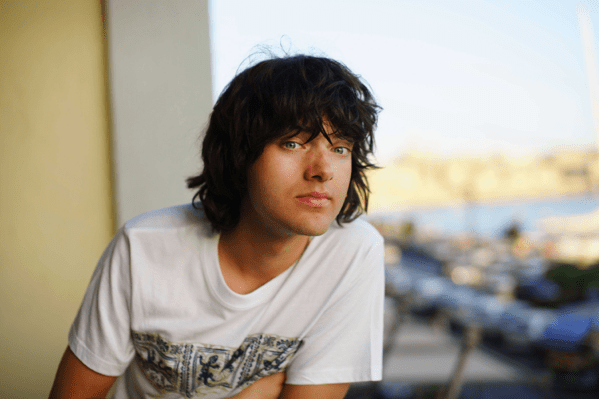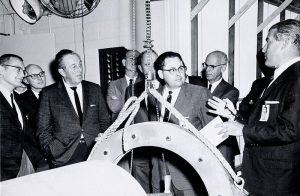“For society to progress, we should not only move forward but also cleanup after ourselves.”1

By NOAA | Courtesy of Wikimedia Commons
Over the last forty years, our oceans have been filling with tons of plastic debris. The plastic is carried by the ocean currents and it all converges in five major accumulation zones, commonly called “Garbage Patches.”2 Many scientists predict that if this problem is not solved, there will be major consequences. Garbage will block the sunlight in the oceans, resulting in many species of sea plants and animals dying. Moreover, the environment will be affected in such ways that the entire food chain of the world will suffer major changes. Dutch inventor Boyan Slat has come up with an idea to solve this problem.3
Boyan Slat is a 24-year-old Dutch inventor, who has been interested in engineering projects since he was very young. At the age of fourteen, he even set a Guinness World Record by launching 213 water rockets at the same time.4 When he was sixteen, he went diving in the waters of Greece and was so surprised to see more plastic underwater than fish. That was the moment when Slat began the idea of cleaning up the ocean. Over the last forty years, millions of tons of plastic have entered the oceans creating huge garbage patches. The largest such patch is located between Hawaii and California. After his trip to Greece, Boyan became obsessed with this problem. During high-school, all of his science projects were about understanding this problem and trying to solve the “million-dollar” question “why this cleanup is considered impossible?”5

After high-school, Boyan was invited to TEDtx to tell the world his idea. At first, his ideas didn’t seem to be really interesting to the public, so he went on with his life. He started working as an aerospace engineer in TU Delft, but he just couldn’t let go of his idea. But the simple thought of not being able to come up with a solution to this major problem was killing him. He was thinking about the terrible consequences, in several years, for the planet if no one did anything.6
After several months he came into the spotlight again because some news sites had picked up his TED speech and became interested in his story. Slat even dropped out of college to pursue his dream.7
He had always enjoyed solving problems and puzzles. But this time was going to be different. This time the puzzle was to get rid of the plastic in the oceans. He just had to find the perfect pieces to accomplish that. At the young age of eighteen, he founded a non-profit organization called The Ocean Cleanup, in order to develop new technology to tackle this almost impossible task.8
And this is when the real adventure began for Slat. Instead of picking up all the plastic bottles with nets, which according to experts it would cost millions of dollars and take thousands of years, his idea was to use the power of natural currents to gather plastic into long floating rubber barriers. But developing this great plan wasn’t an easy task. It required money, time, and many experts in different fields. In an interview, Slat said “When I started, I thought I would likely fail, and I still might, but considering the scale of the problem, it was important to at least try.”9
His ideas started coming together when several experts, such as engineers, oceanographers, recycling companies, and scientists volunteered to complete a study, which ended up indicating that the The Ocean Cleanup project had a feasible and viable method for removing large amounts of plastic. But this was only the first step. Slat still needed a lot of money to start the project. So his next step was to take his story and project to the rest of the world. He has since gained the support of 160 countries, 38,000 funders, and collected over 2 million USD. With this money, he was closer to accomplishing his dream, but, again, this was just another piece of a big puzzle.10

Later, The Ocean Cleanup started developing prototypes, then getting into trials, failing and learning from mistakes, and finally the got it right. They mapped an area of 3.5 million squared kilometers of plastic and marine debris, known as the “great pacific garbage patch.” After that, Slat gave an interview arguing that most people had an image of this patch as an island where you can practically walk on, but that couldn’t be more wrong. It stretches for millions of kilometers and it would take thousands of years to clean it up.11 So he targeted that area to clean first. The first Ocean Cleanup system was launched on September 8, 2018. He is hoping to clean up to 50% within five years.12
This amazing story is only getting started, so if you want to follow the progress of this project, you can follow their official organization page (www.theoceancleanup.com).
- The Ocean Cleanup, “The largest Cleanup history,” The Ocean Cleanup, June 6, 2017. Accessed September 8. www.theoceancleanup.com. ↵
- NOAA, “Great Pacific Garbage Patch,” National Geographic, June 5, 2015. Accessed September 8. https://www.nationalgeographic.org/encyclopedia/great-pacific-garbage-patch/. ↵
- U.S. Government Publishing Office, “Endangered status for North Pacific and North Atlantic Right Whales,” (Federal register: Vol. 73, No. 45. Thursday, 2008), 12024-12030. ↵
- Viveke Venema, “The Dutch boy mopping up a sea of plastic,” BBC News, October 17, 2017. Accessed September 7. https://www.bbc.com/news/magazine-29631332. ↵
- Susan Caminiti, “Thiel backing 22-year-old’s dream to clean up world’s oceans,” CNBC.com, April 22, 2017. Accessed September 5. https://www.cnbc.com/2017/04/20/thiel-benioff-backing-22-year-olds-dream-to-clean-up-worlds-oceans.html. ↵
- The Ocean Cleanup, “How it all began,” The Ocean Cleanup, June 6, 2017. Accessed September 8. www.theoceancleanup.com. ↵
- The Ocean Cleanup, “How it all began,” The Ocean Cleanup, June 6, 2017. Accessed September 8. www.theoceancleanup.com. ↵
- Susan Caminiti, “Thiel backing 22-year-old’s dream to clean up world’s oceans,” CNBC.com, April 22, 2017. Accessed September 5. https://www.cnbc.com/2017/04/20/thiel-benioff-backing-22-year-olds-dream-to-clean-up-worlds-oceans.html. ↵
- Viveke Venema, “The Dutch boy mopping up a sea of plastic,” BBC News, October 17, 2017. Accessed September 7. https://www.bbc.com/news/magazine-29631332. ↵
- The Ocean Cleanup, “Milestones,” The Ocean Cleanup, June 6, 2017. Accused September 8. www.theoceancleanup.com. ↵
- Marian Liu, “Great Pacific Garbage Patch Now Three Times the Size of France,” CNN, 23 Mar. 2018. Accessed September 6 2018. www.cnn.com/2018/03/23/world/plastic-great-pacific-garbage-patch-intl/index.html. ↵
- The Ocean Cleanup, “Milestones,” The Ocean Cleanup, June 6, 2017. Accessed September 8. www.theoceancleanup.com. ↵



78 comments
Miguel Rivera
I’m glad to see that the Ocean Cleanup project is on track to at least combat this monster of a mess. Out of sight, out of mind is the term used for things that we are uncomfortable with dealing with, and this is one of those events. The problem is that it has been caused by us! It’s worrisome to see where our environment is headed, but we are more than capable of fixing issues and preventing further damage to our planet.
Christopher Hohman
Nice article. The pollution of the world’s oceans is a huge problem that we all must work together to try and fix. I admire this man’s determination in his mission. I had never heard of this project before and now that I have I feel hope for the future of our oceans. However, having fifty percent of the garbage patch cleaned up in five years is really ambitious. What happens if these devices he has constructed encounter bad weather? Or what if currents shift. I hope that all these problems have been addressed
Engelbert Madrid
It’s interesting to see that there are young adults working and being global citizens that are making the change for the world. Boyan Slat is one of those people that believe that in order to move forward, the world must clean their mistakes. In my opinion, I agree as well, because everyone has ideas for improvement, yet there is no ideas flourishing for solving the issues that little by little is destroying the world’s environment.
Mariah Cavanaugh
The topic of your article, much like the recent report released on climate change, was horrifying. I am in awe of his resilience and that he refused to accept it when people said the cleanup would be impossible. The Ocean Cleanup project sounds amazing and hopefully with more programs such as this one we can avoid the destruction of our planet.
Robert Freise
I have heard about this garbage patch located in the pacific ocean. I have seen an actual documentary of a guide that ventured out in the middle of the pacific ocean to find the patch that was bigger than Texas. There was no visible trash the size of Texas, but the broken down trash that was visible in the water or just samples of ocean water were seriously contaminated. Good read and we need to start using biodegradable products to stop the output of constant litter.
Avery Looney
This article is very interesting and well written. The amount of trash in the ocean is becoming a significant problem, and we have to do something about it now. Boyan Slat has taken measures to fix this immense issue. His research and different ideas are projected to clean up 50% of this plastic garbage within the next five years.
Rylie Kieny
I think this is a very interesting topic that isn’t shared enough. I have heard of the overwhelming amounts of pollution in the ocean and the negative effects that can come because of it but what I haven’t heard much of is what is being done to combat it. Our oceans cover more of our planet than anything else and therefor should be protected at all cost. It is really awesome that Slat has dedicated his life to preserving our planet for those who will follow. Although cleaning up the oceans seems like an impossible task it is still one worth trying to accomplish.
Caden Floyd
It’s great to tide someone who loves solving problems so much put their passion to good use. Personally I would’ve loved to see him set off those 213 water rockets at the same time, but his idea to clean up the oceans was a little more important. He dropped out of college to pursue his dream, that’s dedication. I was happy to hear that in the Ocean cleanup got it right and is hoping to clean up to 50% in just five years.